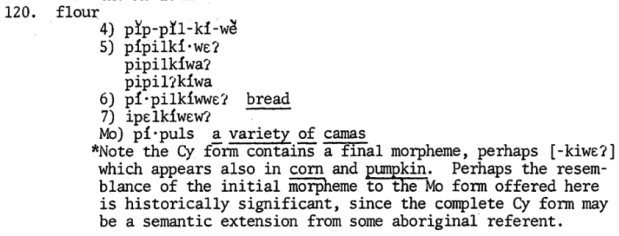Cayuse language implications for Chinuk Wawa?
The Molala (or “Molalla”, “Molale”, “Pole Alley” etc.) language too, maybe.
Today’s post is in honor of the great Pacific Northwest and Australian anthropological linguist,
Bruce J. Rigsby, 1937-2022.
R.I.P.
Elder Bobby Stewart and Bruce Rigsby (image credit: University of Queensland)
But I think the relevance of Cayuse and Molala to deep questions about Chinook Jargon is limited to just one word.
A small dose of background information first here…
Bruce Rigsby wrote a definitive study of whether two little-known northern Oregon languages, Cayuse and Molala, are related to each other, to the proposed “Penutian phylum” of languages, or both.
This is “The Waiilatpuan Problem: More on Cayuse-Molala Relatability”, Northwest Anthropological Research Notes 3(1):68-146.
Rigsby does not find the two to be related. Cayuse is considered a “language isolate”, and it certainly strikes me as quite different from its neighbors. Molala is tentatively thought by some to belong to a “Plateau Penutian” family, along with Klamath and Sahaptian.
Another point that Rigsby reports is that non-Cayuse Native people had a perception of the Cayuse language as so different from their own (and so impossible to learn) that it struck their ears as “sticks breaking”, p. 75. Quite reminiscent of how Indigenous folks perceived the Chinookan languages. Interesting, then, that early explorer JK Townsend’s informant on Cayuse language was the Métis J-B Dorion (p. 90)!
Less surprising is the number of potential borrowings into Cayuse from Southern Interior Salish, which used to be spoken along the middle Columbia River zone (George Gibbs 1877). Glancing through Rigsby’s paper, I noticed ‘antelope’; ‘mouth’; ‘no’ (which was also loaned into Nez Perce); and some other possibilities. I don’t know of scholars having suggested this cultural connection before — but the word “Cayuse” itself has been suggested by my colleague Dr. Sally Thomason to be a Salish horse term, ‘spotted face’. Thomason and her student Nicholas Pharris also wrote a paper on “Lexical Transfer between Southern Interior Salish and Molalla Sahaptian.”
And it’s very well known that by the time Euro-Americans showed up, the Cayuses had mostly switched away from their language to the unrelated lower Nez Perce (Sahaptian family). There was a longstanding close relationship between the Cayuses and the neighboring Sahaptians, including Umatillas. So now, there are vast numbers particularly of Nez Perce words and names documented as having been provided to researchers who were trying to find out more about the real old Cayuse language.
That one Chinuk Wawa word that I suspect Cayuse and Molala might help us out with?
Saplél ‘flour; bread’.
I have previously examined this word as a seemingly Sahaptian-family term, but without being able to establish an etymology.
Rigsby’s paper, which amounts to the only existing dictionary of Cayuse,* shows these forms for ‘flour’ (“Cy” is his abbreviation for “Cayuse”; the numbers 4, 5, 6, 7 code various researchers who supplied data; “Mo” = Molala language):
flour
4) pĭp-pĭl-kí-wě
5) pípilkí•wεʔ
pipilkíwaʔ
pipilʔkíwa
6) pí•pilkíwwεʔ ‘bread’
7) ipεlkíwεwʔ
Mo) pí•puls ‘a variety of camas’Note the Cy form contains a final morpheme, perhaps [-kiwεʔ] which appears also in [the Cayuse words for] ‘corn’ and ‘pumpkin’. Perhaps the resemblance of the initial morpheme to the Mo form offered here is historically significant, since the complete Cy form may be a semantic extension from some aboriginal referent.
Proceeding from Rigsby’s partial morphemic analysis, there is a Cayuse stem (or maybe root) ~ /pipil/ associated with the meanings ‘flour; bread’. Perhaps Cayuse, like virtually all PNW languages, made use of reduplication for various grammatical effects, so we can hypothesize that here we have a reduplication of a root ~ /pil/.
Molala has a similar-sounding word, with a meaning that’s got a good chance of being relevant — various roots traditionally were pounded into flours, and/or preserved in the form of loaves/cakes.
This all leads to my idea that maybe Cayuse, Molala, or both supply us with an additional etymological possibility to explain the quite old Chinook Jargon word saplél for ‘flour; bread’ that we know to have originated in precisely the same geographical region, the big bend of the Columbia River.
* Rigsby collected essentially all known Cayuse-language data in this paper, and arranged it under alphabetical English entries, with some parsing notes. A superb project for a Master’s or PhD student would be to further morphologically analyze the Cayuse data, and to create a grammar description and a fuller two-way dictionary.
The most complete reference on the Molalla language is Nick Pharris’s dissertation.
Bonus fact:
Rigsby’s entry for ‘wheat’ references a “Wishram” (Kiksht Upper Chinookan) supposed loan from French, wa-láptin ‘wheat’. That word is news to me. What (Métis) French word could the stem -láptin have come from?


